Australia So Much to See


As the dancing became livelier, the dance floor rocked more and more. Suddenly the turna slipped off and plummeted to Earth,
hitting with such force that the Tnorala crater was formed, and the turna and baby were buried deep down under the rubble. The
We had intended staying in the spacious parking area, but on reading the above, we respected the wishes of the custodians and continued
on.
Aboriginal people say that a long time ago, before white man came, their ancestors lived at Tnorala. They hunted, camped and
performed ceremonies here.
One day, early in the morning, a man climbed up the rocks, hunting for kangaroo. When he came
back, he found all his people, men, women and children dead, killed. He knew that the kadaitcha men had done it.
This
man went off and told the rest of the family, who lived along the nearby ranges. These people followed those kadaitcha men,
who came from the desert country, to the south of here. The kadaitcha didn't make it back to their community. They were
killed by the avenging family.
After the massacre, Tnorala became what Aboriginal people call a 'sorry' place: no-one has lived
here since because of sorrow over the lost family. It is out of respect for the people that passed away here that the Aboriginal
custodians ask visitors not to camp at Tnorala.
Signage at Tnorala Conservation Reserve
The
The
Shatter cones, formed when the earth has been struck by a severe impact, were found, indicating it was a meteorite crater, but unlike
other meteorite craters, no particles from a meteor were ever discovered. Gosse Bluff as it became known was the most studied
crater in
We drove further towards this huge crater and at first took a wrong track. We met a group of feral camels. These were
the first of many we saw in
Approaching Gosse Bluff, we were surprised to see blackboys (grass trees). These are common in the south west of Western Australia
and similar grow in the Flinders Ranges in South Australia as well as in other states, but we had not seen them before in the desert
areas. We now know that many species of Xanthorrhoea grow throughout
We continued west from Redbank in the
The Mystery of Gosse Bluff (Tnorala)
Approaching from the north via
It was no mystery to the Western Arrernte Aboriginal people who lived in the area. They knew how Tnorala was formed.
To the south, the gentle hills gave way to a flat plain, with a bare range looking so out of place. "What is it?" I puzzled,
before realising I was looking at Gosse Bluff.
Rising sharply from Missionary Plain some 200 kilometres to the west of Alice Springs, this ring of steep hills was called
Central Australia 2008. The mystery of the Gosse Bluff (Tnorala) impact crater.

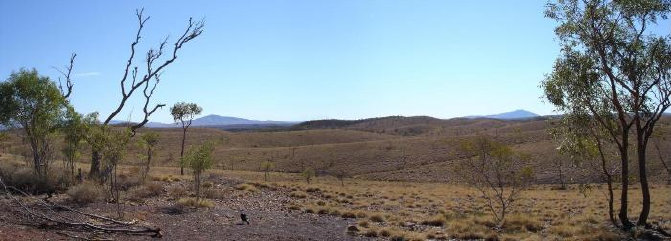
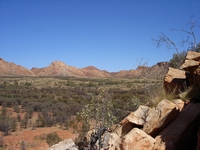
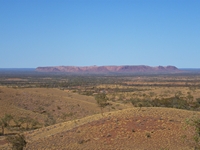
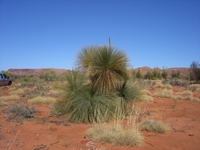
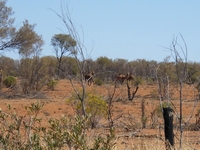
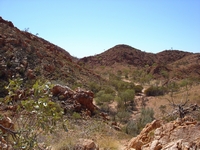
Climbing onto a rocky knoll within the crater, we looked back to the track which comes right into the crater (picture on left) and
saw the full expanse of the interior of the crater with the car park in the centre of the dark green scrub (picture on right).